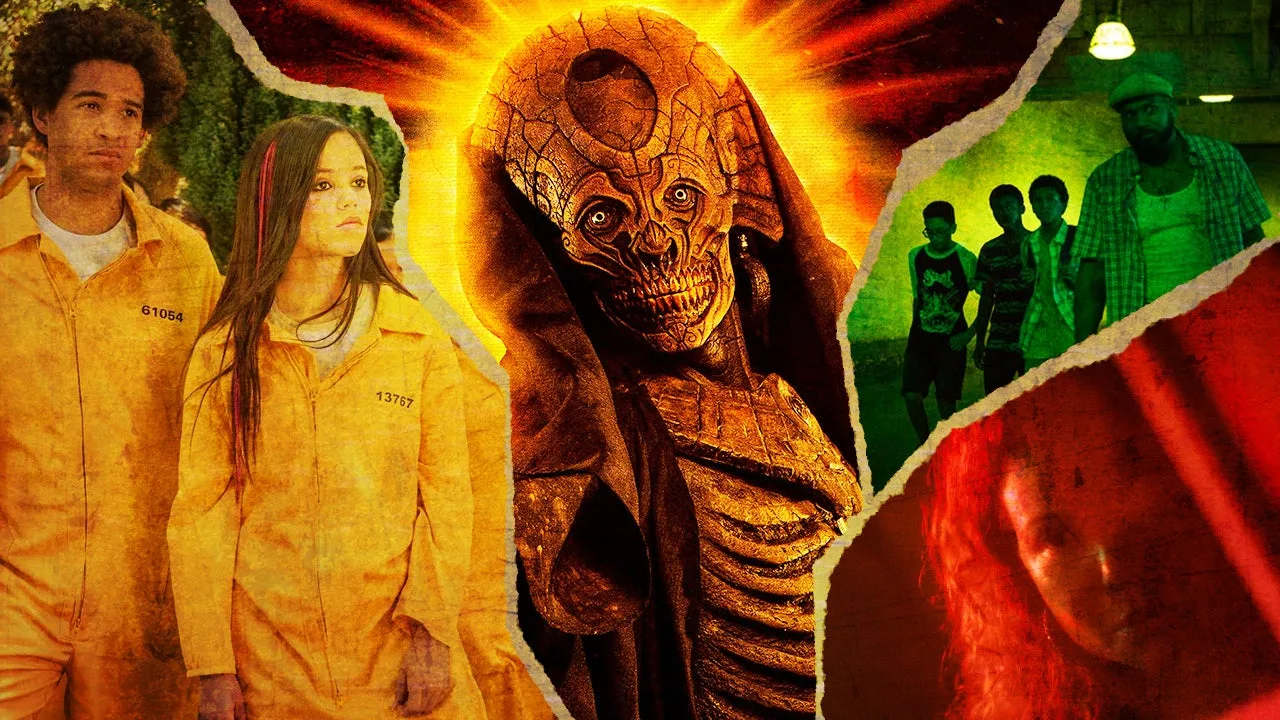Who’s Afraid of the Big Bad Bruja? Why Many Latinos Love the Macabre
Who’s afraid of the big bad bruja? Well, admittedly, I am. I grew up with whispers of family curses and mal de ojo and protection against malevolent witchcraft. To this day I still refuse to allow an Ouija board anywhere near me. The thing is, the cultural conditioning of my childhood has left me fascinated by creepy horror stories. Really, if I’ve learned anything it’s this: there can sometimes be an (oft-unacknowledged) symbiotic relationship between Latine identity and the macabre.
Hispanic Heritage Month may be coming to a close, but this spooky season there’s plenty to celebrate in scary stories for, by, about and starring Latines.
How Horror Draws on Latino Cultural Traditions
One need look no further than traditions like Día de Muertos – a lively and technicolor celebration of those who have passed. It’s a memorialization of the dead, skeletal imagery abound as calaveras decorate ofrendas and more. Maybe these aren’t necessarily the trappings of Halloween, but proximity to the afterlife is gleefully embraced from the youngest child to the most wizened elder.
But it isn’t just these colorful celebrations we can look to while mapping the relationship Latine people have with morbidity. We’ve horrors embedded into our cultural folklore. La Llorona will drag you into the lake, her mournful weeping a soundtrack to many a childhood nightmare. El Chupacabra stalks the nighttime wilderness, ravenous and ruthless. In fact, this year’s Universal Halloween Horror Nights even offers a haunted house entirely centered around such myths. Titled “Monstruos: The Monsters of Latin America,” visitors are greeted by imaginings of El Silbón, La Lechuza and Tlahuelpuchi as they navigate sinister halls. These are legends passed from generation to generation – age-old entertainment mimicking the shape and feel of fear but all the more fun for it.
This isn’t a temporary phenomenon or even a new one. Take the 1931 production of Dracula, filmed simultaneously in English and Spanish as Hollywood eyed a way to connect to a whole new audience. Directors from Juan Bustillo Oro to Guillermo del Toro have made names for themselves by exploring creatures of darkness. This year, a new horror anthology, Satanic Hispanics, tells tales of terror across different regions of Latin America. The latest installments in the Scream franchise have been led by two Latinas, Melissa Barrera and Jenna Ortega. In fact, Ortega herself has begun carving her way into the scream-queen-goth-girl space with roles in X, American Carnage, Wednesday and the much anticipated Beetlejuice 2.
A CNBC article even noted a correlation at the box office. In an article about projected performance of The Exorcist: Believer among Hispanic audiences, they cite a Comscore/Screen Engine PostTrak Audience Survey that shows an overrepresentation of Latine moviegoers at the horror box office: 26% versus 20% for other genres. As of October 1st, audience demographics for Saw X were recorded at 44% Latine. In fact, a 2023 UCLA Hollywood diversity report found that horror films were 4 of the 10 top theatrical releases for Latinx audiences in 2022.
Religion and Horror
Latine horror enthusiasts might see themselves within the characters of HBO’s Los Espookys, a comedy following a group of friends that set out to turn their love of the creepy into a lucrative business. Together, they painstakingly combine prosthetics, props, meticulous staging and a heavy dose of theatrics to create monsters, aliens and more. It’s vital, actually, that the very first episode sees the crew stage an exorcism at the request of a local priest. This is a tacit acknowledgement of one the the major drivers of Latine fascination with terror: religion.
Not all Latine Christians are Catholic, but Catholicism itself has a deeply rooted history in Latin America. This traces back to Spain’s colonization efforts, which included the establishment of Catholic missions as a means of converting the indigenous populations. While the goal of Spain’s Catholic Church was the eradication of indigenous traditions and practices, there were some instances where religions melded instead. Santería, for instance, saw the integration of religious practices of the Yoruba people (brought as slaves to work Cuban tobacco and sugarcane plantations) with elements of Catholicism.
Its not that Catholicism or its practitioners are somehow hardwired horror enthusiasts, rather that there are echoes of darker spirituality in the gothic architecture and sumptuous imagery characteristic of Catholic aesthetics – the fires of Hell, the cries of the damned, the demons crawling ferociously to do the bidding of the Devil himself.
One particularly visual representation of God’s power over demonic evil? Intensely gruesome exorcisms. Films about demonic possession can draw massive Latine interest, like 2022’s Prey for the Devil, whose opening weekend saw a 38% Hispanic/Latino turnout. What we can draw from here is not that religious Latines are preternaturally superstitious, but rather that centuries old cultural influences and generational traditions can cultivate an environment of fascination with the darker sides of spirituality.
More From IGN’s Hispanic Heritage Month Celebration
What Spider-Man: Miles Morales Gets Right About Cultura and the Authentic Puerto Rican Experience7 Iconic Hispanic Characters in Video Games9 Badass Latino Superheroes to Celebrate for Hispanic Heritage Month
Horror as Social Allegory
Horror is often at its best when it acts as a vehicle to examine social woes, a blood-soaked magnifying glass peering into the complexity of human emotion. For example – Get Out, It Follows, Night of the Living Dead and more. Even this year’s horror hit, Talk To Me, is a petrifying exploration of grief and addiction wrapped within an allegory of demonic possession. Netflix’s Vampires Vs. The Bronx serves as a sort of tongue-in-cheek example as it documents a vampiric invasion of a predominantly Latine neighborhood of the Bronx via the trappings of gentrification. The comparison is drawn quite clearly. Vampires infiltrate by buying up property from locals, spinning business from neighborhood institutions into glitzy overpriced storefronts, consuming their victims economically and, unfortunately, quite literally as well.
In this way, horror can function like comedy. It reflects our lives and our issues recognizably enough that we see ourselves represented but adjacently enough that we can freely enjoy them. Vampires aren’t really eating these neighborhoods alive but displacement can make it feel that way. At least in this story, it’s the community that wins in the end.
In this way, horror can function like comedy. It reflects our lives and our issues recognizably enough that we see ourselves represented but adjacently enough that we can freely enjoy them.
The Horror of Dolores Roach is another streaming gem. Justina Machado (whom you may know from the sweet family comedy One Day At A Time) plays Dolores, an ex-con who gets up to some Sweeney Todd level antics as a couple of heat-of-the-moment murders lead to human meat being served out of her maniacal friend’s empanada shop. It covers a lot of ground, namely the institutional obstacles ex-prisoners face when trying to get back on their feet after release. Has Dolores’ life not too been cannibalized by a system she fell victim to? Or the gentrification that ravaged her community after she was torn from it? It’s complex and, no, Dolores isn’t necessarily a good person, but she is one determined to tell her story on her own terms.
At the end of the day there is a rich catalog of freaky stories created or enjoyed by Latine audiences: dark fairytales like Issa López’s Tigers Are Not Afraid, anthologies like Guillermo del Toro’s Cabinet of Curiosities, tales rooted in myth like Jayro Bustamante’s La Llorona and so much more.
There’s no simple explanation for this undeniable fascination with the macabre – no one reason for this particular response to the spooky and the scary. Latine people aren’t (and have never been) a unified block with the exact same beliefs, ideas or traditions across cultures. Some of it may come from historical context, some might be the luck of personal preference for these chilling stories, but what can’t be denied is that there is certainly a relationship here to explore.
IGN is celebrating Latine and Hispanic Heritage Month by raising funds for Hispanic Scholarship Fund. If you would like to help us reach our goal, head on over and donate here.











Post Comment